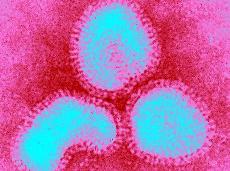Research: Why bird flu has not caused a pandemic

Bird flu viruses would have to make at least two simultaneous genetic mutations before they could be transmitted readily from human to human, according to research published in PLoS ONE.
The authors of the new study, from Imperial College London, the University of Reading and the University of North Carolina, USA, argue that it is very unlikely that two genetic mutations would occur at the same time. The study adds to our understanding of why avian influenza has not yet caused a pandemic.
Earlier this year, the Imperial researchers also showed that avian influenza viruses do not thrive in humans because, at 32 degrees Celsius, the temperature inside a person’s nose is too low.
This study suggests that one reason why H5N1 has not yet caused a pandemic is that two genetic mutations would need to happen to the virus at the same time in order to enable it to infect the right cells and become transmissible. At present, H5 viruses can only infect one of the two main types of cell in the mouth and nose, a type of cell known as a ciliated cell. In order for H5 to transmit from human to human, it would need to be able to infect the other, non-ciliated type of cell as well.
To infect a cell, the influenza virus uses a protein called HA to attach itself to a receptor molecule on the cell’s surface. However, it can only do this if the HA protein fits that particular receptor. The research shows that H5 would only be able to make this kind of adaptation and fit the receptor on the cells that are important for virus transmission if it went through two simultaneous genetic mutations.
Professor Wendy Barclay, corresponding author of the study from the Division of Investigative Science at Imperial College London, said: “H5N1 is a particularly nasty virus, so when humans started to get infected with bird flu, people started to panic. An H5N1 pandemic would be devastating for global health. Thankfully, we haven’t yet had a major outbreak, and this has led some people to ask, what happened to bird flu? We wanted to know why the virus hasn’t been able to jump from human to human easily,” she said.
“Our new research suggests that it is less likely than we thought that H5N1 will cause a pandemic, because it’s far harder for it to infect the right cells. The odds of it undergoing the kind of double mutation that would be needed are extremely low. However, viruses mutate all the time, so we shouldn’t be complacent. Our new findings do not mean that this kind of pandemic could never happen. It’s important that scientists keep working on vaccines so that people can be protected if such an event occurs,” added Professor Barclay.
Professor Ian Jones, leader of the collaborating group at the University of Reading, added: “It would have been impossible to do this research using mutation of the real H5N1 virus as we could have been creating the very strain we fear. However, our novel recombinant approach has allowed us to safely address the question of H5 adaptation and provide the answer that it is very unlikely.”
In addition to explaining why bird flu’s ability to transmit between humans is limited, the new research also gives scientists a better understanding of the virus. They believe that this could help the development of a better vaccine against bird flu, in the unlikely event that one was needed in the future.
The researchers used a realistic model of the inside of a human airway to study H5 binding to human cells. They made genetic changes to the H5 HA protein to change its shape, to see if they could make the virus recognise and infect the right types of cells. Results showed that the virus would need two genetic changes occurring at once in its genome before it could infect these cells.
The researchers then investigated intermediate forms of the virus, with one or the other mutation, to see if the change could occur gradually. They found that intermediate versions of the virus could not infect human cells, so would die out before they could be transmitted. The researchers say this means the two genetic mutations would need to occur simultaneously.
Source: Imperial College London













